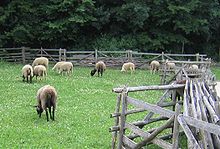Merino sheep

The Merino landscape (or Württemberger ) belongs to the breed of Merino sheep . With around 30% of the sheep population, it is the most frequently bred farm sheep in Germany.
history
The first merino sheep come from the Berbers in North Africa and came to Spain in the 12th century. The starting point for breeding merino sheep in Germany was the import of migratory, Spanish fine wool sheep called Ovejas merino to Germany (Saxony) around 1765. There they were crossed with some land sheep breeds because of their beneficial properties. And essentially three races arose:
- Merino sheep
- Merino long wool sheep
- Merino meat sheep
On the one hand, the Merinoland sheep are popular suppliers of wool because of their fine and fast-growing wool . On the other hand, they are very resistant and have a high weight gain with a high rearing rate, which allows an economical lamb production.
Breeding goal
The breeding goal then as now is to breed woolly and meat sheep that is as resilient as possible, suitable for all terrain and fertile .
The wool output of the buck is 6.5 to 7.5 kilograms of sweat wool , of the ewe it is between 4.0 and 4.5 kilograms. The wool fineness is 26–28 micrometers. The yield is around 50%.
The fattening output for bucks is between 130 and 160 kilograms and ranges from 70 to 100 kg for ewes. The daily gain is between 400 and 450 grams and the slaughter yield is 50%.
literature
- A. Fischer: German sheep breeds . In: K. Strittmatter, A. Fischer, K.-H. Kaulfuss, G. Nitter, H. Puls (Ed.): Schafzucht . Ulmer, Stuttgart 2003, p. 88-118 .
Individual evidence
- ↑ Merino landscape. (pdf; 90 kB) (No longer available online.) Bavarian State Institute for Agriculture, formerly in the original ; Retrieved February 22, 2010 . ( Page no longer available , search in web archives ) Info: The link was automatically marked as defective. Please check the link according to the instructions and then remove this notice.
- ^ Katharina Seuser, Klaus Dittrich: Merinolandschaf. (No longer available online.) In: aid infodienst. Food, Agriculture, Consumer Protection e. V., archived from the original on November 9, 2011 ; Retrieved February 22, 2010 . Info: The archive link was inserted automatically and has not yet been checked. Please check the original and archive link according to the instructions and then remove this notice.
- ↑ Knut Strittmatter: The fine wool breed of merino meat sheep in Germany - status and problems . In: Archive Animal Breeding . tape 47 . Dummerstorf 2004, p. 25-35 ( pdf ). pdf ( Memento of the original from September 28, 2013 in the Internet Archive ) Info: The archive link was inserted automatically and has not yet been checked. Please check the original and archive link according to the instructions and then remove this notice.